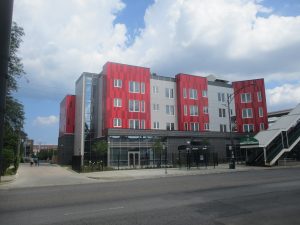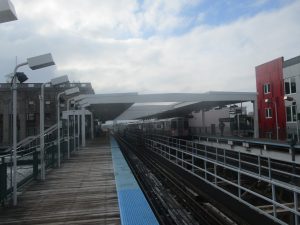Cook County agency looking to redevelop historic Woodlawn Bank building
By Igor Studenkov For Chronicle Media — October 3, 2018
The new Woodlawn Station affordable housing development at the northeast corner of 63rd and Cottage Grove. (Photo by Igor Studenkov/for Chronicle Media)
To anyone who’s ever been at the Green Line Cottage Grove ‘L’ station in Chicago’s Woodlawn neighborhood, above the intersection of 63rd Street and Cottage Grove avenue, the building is hard to miss.
The former Washington Park National Bank building looms large over the intersection’s southwest corner, towering above the elevated station platforms. The first floor has been boarded up, and many windows are broken, but much of the decorative detailing on the front still survives, and one can still make out the bank’s name above the top floor.
Now, the Cook County Land Bank Authority is looking to breathe new life into the building. The agency is currently looking for a development to transform into a mixed-use development with retail, commercial and healthcare components. Ultimately, they are looking for something that would encourage economic development and provide job opportunities. But while CCLBA is hoping to preserve the building, demolition and replacement isn’t entirely off the table.
CCLBA was established by the Cook County Board of Commissioners in 2013 to address an issue that has been affecting not just much of the South and West sides of Chicago, but many of the suburbs — abandoned residential, commercial and industrial buildings and land parcels that have been allowed to remain vacant for years, if not decades. Issues such as foreclosures, unpaid taxes and high costs of repairs necessary to bring the buildings up the code led its owners to either sit on their properties or abandon them altogether.
The land bank works to acquire such properties by either buying them up or having the owners give them up. It then works to resolve tax liens and other issues, so that it can eventually be sold to a private developer without any financial baggage.
As previously reported by the Chronicle, 63rd Street used to be one of the busiest commercial strips in Chicago. But throughout the 1950s and 1960s, many of the long-time businesses moved out or closed. While some businesses survived — most notably, Daley’s Restaurant located on the other side of the intersection is currently the longest-operating restaurant in the city — the shopping strip went into decline. The last three decades saw several attempts to revive it. While there has been some successes, much of the corridor is still dotted by vacant lots and abandoned buildings.
Through it all, the Washington Park National Bank building has been a neighborhood fixture. It was built in 1924 because the bank was looking for a more high-traffic location. The building included now boarded up storefronts on 63rd Street side, and the bank’s main entrance was located on the Cottage Grove site. According to South Side Weekly, the bank went through several ownership changes before being abandoned. In 2016, Preservation Chicago felt concerned enough about the building’s future to put in on that year’s list of the city’s most endangered buildings.
The decision to build the Obama Presidential Library in Jackson Park, east of Woodlawn, renewed talks of development and concerns about displacement caused by gentrification. And, since Cottage Grove station is currently the closest ‘L’ station to the future library site, the station and the surrounding intersection has been a part of it.
Over at the northeast corner of the intersection, Preservation of Affordable Housing, a nonprofit affordable housing developer, recently completed the Woodlawn Station mixed-use development. The building includes retail spaces on the first floor and 55 units of various sizes on the remaining three floors. The Chicago Transit Authority has been discussing ways to spruce up the station itself, while the Chicago Department of Transportation is looking into ways to improve traffic flow.
CCLBA bought the Washington Park National Bank building in 2017 in a tax sale. As Rob Rose, the land bank’s Executive Director, explained to the Chronicle, his employer teamed up with the Metropolitan Planning Council nonprofit organization to do community outreach to figure out what people of Woodlawn want to see.
Rose said that they reached out to neighborhood stakeholders — including elected officials, heads of local nonprofits and community activists to lay the groundwork and help with the outreach. He said that it was important for CCLBA and MPC to make sure they hear as many different ideas and opinions as possible.
The two organizations held three two-hour community meetings. Rose said that approximately 200 people attended. What came out of those meetings was a vision for a community hub that would include “including retail shops, commercial offices, and medical facilities” and serve as the “economic and jobs generator, as well as the gateway to the neighborhood for those getting off the ‘L’ from the station above. They are also looking for something that would be pedestrian friendly, especially for seniors and people with disabilities, as well as to inspire further revitalization in the surrounding area.
The concept is similar to Auburn-Gresham Healthy Lifestyle Building, an initiative by the Greater Auburn-Gresham Development Corporation to redevelop the former furniture store near the intersection of 79th and Halsted streets. But unlike the Washington Park Bank, it doesn’t have any government involvement, and it would include a performance space as well.

The new Woodlawn Station development (right) was recently built on the northeast side of 63rd/Cottage Grove intersection while Cook County Land Bank Authority is looking to redevelop the former Washington Park National Bank building (left). Both developments seek to revitalize the area around Cottage Grove Green Line ‘L’ station (foreground). (Photo by Igor Studenkov/for Chronicle Media)
The initial press release about the project was vague about whether it would involve renovating the existing building or replacing it with a new structure. Rose clarified that both options were on the table.
“Our preference is that building will remain in place and [that it] is rehabbed, but we will accept proposals in teardown and demolition,” he said. “The way we score [bids], the preference will be given to someone who [proposes] adoptive reuse.”
Either way, Rose said that one major thing that came out of the community outreach is that, whatever tenants go into a building, it would have to be something local residents can’t afford. For example, he said, a Tiffany’s jewelry store may be a good tenant, but since most of the current Woodlawn residents can’t afford to buy expensive jewelry, it would be ruled out.
Another important component is ensuring that local residents and businesses have an opportunity to work on the project. Rose said CCLBA hired Cando Corporation, which advises companies and public entities on contracting minority-owned and women-owned businesses, to assist them. The company is putting together a database of Woodlawn residents and businesses who are “professional services [providers], contractors, suppliers and tradesmen.” The company is also working with workforce development groups to hire local residents.
The winning bidder would be subject to county rules on women-owned and minority-owned sub-contractors — and Rose said that Cando Corporation will make sure the bidder follows those rules.
The request for proposal document noted that while, as it is usually the case with county agencies, the award would be given to the lowest “responsive and responsible bidder,” preference will be given to a local bidder — but only so long as their bid is no more than 2 percent higher than the lowest bid by a non-local bidder.
CCLBA officially went out to bid on Sept. 13. Rose said that bids will be due on Oct. 31. During November, the land bank will evaluate the proposals and make a recommendation. CCLBA Board of Directors is expected to make the final decision during its Dec. 13 meeting.
Rose said that, ideally, CCLBA would like to see the construction to start at by Spring 2019, the beginning of next year’s construction season. Whether the building would be renovated or replaced, they would like to see the project completed over the next 18-24 months — though Rose emphasized that the exact timetable will depend on the nature of the proposal.
“We don’t want to rush it,” he said. “We want this project to be well thought through, well-financed. We want something that will withstand the test of time, something that will be there for the next 100 years.”
Get your free subscription of the Cook County digital edition
—- Cook County agency looking to redevelop historic Woodlawn Bank building —-




